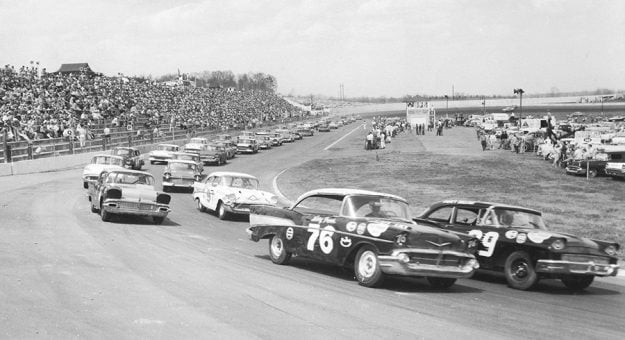Martinsville Speedway has been known for its tight corners, fast straightaways and fender-rubbing action since the track opened on Sept. 7, 1947.
In its 75th season of operation, the famed Virginia track continues to be a cornerstone of the NASCAR Cup Series schedule.
The .525-mile oval was the vision of H. Clay Earles, who was born on a tobacco farm in 1913.
During a trip to Salisbury, N.C., in 1946 to attend several races at a small dirt track with his friend and occasional racer Sam Rice, Earles got the idea to build his own track.
“Man, there looked like there was a million people there, but now I realize it was something like 1,500,” Earles said in the book, “From Dust to Glory” written by Morris Stephenson and Dick Thompson in 1992. “But I thought racing, which was then in its infancy, just might be a pretty good business for me to get into.”
In early 1947, Earles, Henry Lawrence and Rice, who also had a dirt-moving business, began searching for a place to build a race track.
They found it in a 30-acre corn field near Martinsville.
After many months of hard work, their first race was held on Sunday, Sept. 7, 1947. Earles, Rice and Lawrence initially contributed $10,000 each but that number quickly escalated to $30,000 apiece.
They found they could only park 1,400 cars and accommodate 4,000 fans for the 750 seats they had built. A total of 6,103 tickets were sold and an estimated 3,000 saw the race without paying, as there was no fence around the track.
The massive crowd went to the track directly from church, many wearing their Sunday best to their first stock car race. What transpired was a red dust cloud seen for miles that Earles heard about for the rest of his life. Women’s dresses were ruined and many of them carried their shoes to their cars after sinking to their ankles in dirt. Men’s suits, white shirts, ties and hats were also covered in red dust.
Most heading for the parking lot cared little that Red Byron won the race and pocketed $500 from a $2,000 purse.
“I don’t think I had ever been so embarrassed in my life,” Earles said in 1992. “Would you believe I still run into people today who tell me they saw my first race? And they say, ‘yes, and I’ve never been back since. I guess they think we’re still running a dirt race.”
From that day forward, Earles worked to make his track a showplace that fans could enjoy.
“Anything he did, he did right,” said Clay Campbell, Earles’ grandson and track president since 1988. “He wanted to make it the very best it could possibly be. When that first race in 1947 was advertised as a dust-free event, it looked like a bomb had been dropped on the place after only a few laps. So that didn’t sit well with him and that started the process of making things as perfect as possible.
“Even back then with the dirt track and outhouses for restrooms, he had rose bushes planted around them. Little things like that occurred and it continued. That’s what drove him. That’s what made him the happiest. Perfection was in his DNA.”
NASCAR’s Cup Series made its first appearance at the speedway on Sept. 25, 1949, and Byron won again. By then, Earles had increased the track’s seating capacity to 10,000 and made other improvements.
Still, the dust problem persisted and Earles had the track paved in the fall of 1955.
Click below to continue reading.
